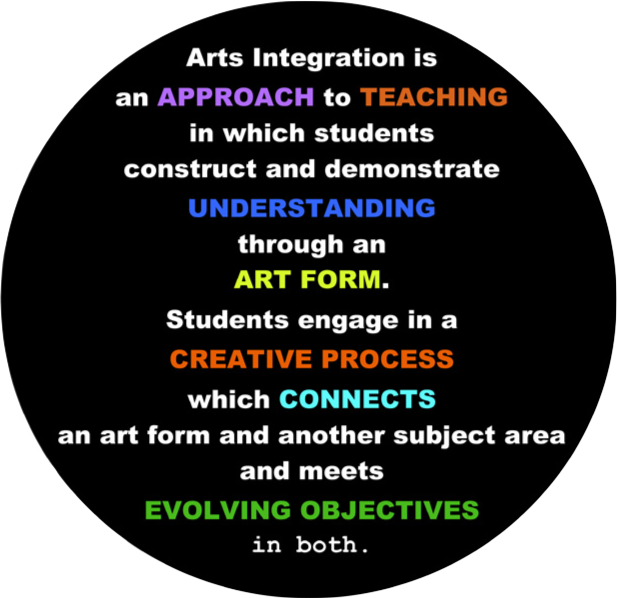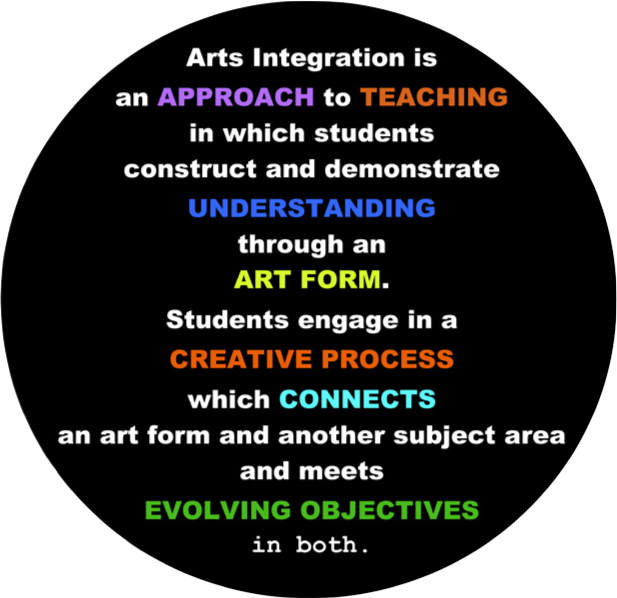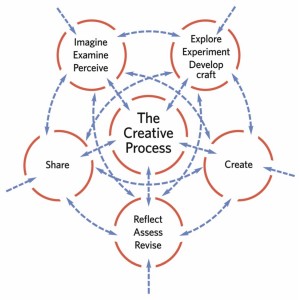
Defining Arts Integration
“Defining Arts Integration”
by Lynne B. Silverstein and Sean Layne © 2010,
The John F. Kennedy Center for the Performing Arts 1
Defining Arts Integration
Across the nation there has been a growing interest in arts integration as an approach to teaching in which the arts leverage learning in other subject areas such as science, language arts, mathematics, and social studies.
Since 1999, the Kennedy Center has been working in an intensive and ongoing way with a network of partnership schools in the Washington DC metropolitan area to provide professional learning experiences for teachers to learn about and implement arts integration. The program, known as Changing Education Through the Arts (CETA) uses a comprehensive definition of arts integration as its foundation. This definition helps over 400 teachers in the program know exactly what arts integration is and how it differs from teaching the arts or just using the arts in the classroom.
The Definition

Inside the Definition
The definition includes terms that have deep connections to the arts and education. The following sections examine each key term. Arts Integration is an APPROACH to TEACHING… approach (n) – a path, road, or other means of reaching a person or place This definition begins with the assertion that arts integration is larger than an activity. Rather, arts integration is an approach to teaching that is embedded in one’s daily practice. An “approach to teaching” refers to how something is taught rather than what is taught. Every teacher has an approach to teaching, whether or not they are aware of it. Approaches fall along a continuum from traditional, teacher-centered instruction to more progressive, student-centered instruction. Ultimately, our approach is based on our beliefs about how students learn. As an approach to teaching, arts integration relies heavily on the progressive, student-centered end of the continuum. This approach to teaching is grounded in the belief that learning is actively built, experiential, evolving, collaborative, problem-solving, and reflective. These beliefs are aligned with current research about the nature of learning and with the Constructivist learning theory. Constructivist practices that align with arts integration practices include:
• Drawing on students prior knowledge
• Providing active hands-on learning with authentic problems for students to solve in divergent ways
• Arranging opportunities for students to learn from each other to enrich their understandings
• Engaging students in reflection about what they learned, how they learned it, and what it means to them
• Using student assessment of their own and peers’ work as part of the learning experience
• Providing opportunities for students to revise and improve their work and share it with others.
• Building a positive classroom environment where students are encouraged and supported to take risks, explore possibilities, and where a social, cooperative learning community is created and nurtured.
Students construct and demonstrate UNDERSTANDING … understand (vt.) – (1) to get or perceive the meaning of; to know or grasp what is meant by; comprehend (2) to gather or assume from what is heard; to infer 3) to know thoroughly; grasp or perceive clearly and fully the nature, character, functioning, etc. of 4) to have a sympathetic rapport with. Constructing understanding of one’s world is an active, mind-engaging process. Information must be mentally acted upon in order to have meaning for the learner. Arts integration provides multiple ways for students to make sense of what they learn (construct understanding) and make their learning visible (demonstrate understanding). It goes beyond the initial step of helping students learn and recall information to challenging students to take the information and facts they have learned and do something with them to build deeper understanding. “In the arts students have central and active roles as meaning makers. This role demands that they not only acquire knowledge but they develop the capacity to reflect on what they are learning and to use it as they interpret and create works of art.” Students’ visible demonstrations of learning serve as both formative assessments to guide instruction and summative assessments to determine what students have learned. For example, when students are challenged to work as choreographers to create a dance that demonstrates how the seasons change, they must build their understanding of the vocabulary and concepts shared by science and dance (such as rotate, revolve, cycles, patterns, and change). Their dance will reflect their understandings and provide teachers with a quick, effective means to determine whether individual students know the difference between rotate and revolve, if a group understood the cyclical nature of the seasons, or if the class has mastered how to demonstrate the concept of change through physical movement.
…through an ART FORM. art form (n) – any branch of creative work in the arts (visual arts, dance, drama, music); the products of creative work. Students can construct and demonstrate their understanding in many ways. Traditionally, they are asked to communicate their learning through a report or on a test. However, when they are involved in arts integration, their learning is evident in the products they create, such as the dance, painting, or dramatization. Students can—and should—have opportunities to construct and demonstrate their understandings in various ways. Nationwide, classrooms have become, and continue to become, more culturally, economically, and academically diverse. And yet, a great deal of instruction relies primarily, and sometimes exclusively, on speaking and writing as the way for students to show what they know. Today’s research points to the power of learning through a variety of senses or modalities. Teachers are encouraged to plan instruction that engages students in visual, aural, and kinesthetic learning modalities so that students can actively process what they are learning. The recognition of the arts as powerful modalities for learning is embedded in this part of the definition. By their nature, the arts engage students in learning through observing, listening, and moving and offer learners various ways to acquire information and act on it to build understanding. They also offer a natural way to differentiate instruction as the arts offer multiple modes of representation, expression, and engagement.3 Additionally, the arts provide an authentic context in which students solve problems such as those encountered by professional artists.
 Students engage in a CREATIVE PROCESS… creativity (n) – an imaginative activity fashioned so as to produce outcomes that are original and of value. The heart of arts integration is engagement in the creative process. Arts integration requires that students do more than repeat (a song), copy (an art project), or follow directions. They must create something that is original and of value. The creative process in the arts is a process not a single event. It includes many interacting phases and each phase is related to every other. When students engage in the creative process, they produce original work that communicates their ideas, insights, points of view, and feelings. The creative process can There are many descriptions of the creative process. The one provided here is a synthesis of ideas from many different sources. In this diagram, the process is made visible as five open circles. 1) Students imagine, examine, and perceive. 2) They explore, experiment, and develop craft. 3) They create. 4) They reflect, assess, and revise, and 5) share their products with others. Arrows indicate the ways one can enter the process and the myriad ways the phases interact. The creative process can be “messy.” It is difficult to predict what will happen, be discovered, or emerge during the process. Learners engage in inquiry and experimentation as opposed to following rigid, step-by-step rules. Some ideas, once explored, do not work well, while other ideas that were not originally considered, may surface as the perfect solution. If teachers are overly concerned with a “neat” process and product, they tend to make the creative choices for students and direct the outcome. In these cases, the creative process is present, but only for the teacher. It is the teacher’s or teaching artist’s responsibility to set a creative problem or challenge for students to solve, but not to take over and solve the challenge for the students.
Students engage in a CREATIVE PROCESS… creativity (n) – an imaginative activity fashioned so as to produce outcomes that are original and of value. The heart of arts integration is engagement in the creative process. Arts integration requires that students do more than repeat (a song), copy (an art project), or follow directions. They must create something that is original and of value. The creative process in the arts is a process not a single event. It includes many interacting phases and each phase is related to every other. When students engage in the creative process, they produce original work that communicates their ideas, insights, points of view, and feelings. The creative process can There are many descriptions of the creative process. The one provided here is a synthesis of ideas from many different sources. In this diagram, the process is made visible as five open circles. 1) Students imagine, examine, and perceive. 2) They explore, experiment, and develop craft. 3) They create. 4) They reflect, assess, and revise, and 5) share their products with others. Arrows indicate the ways one can enter the process and the myriad ways the phases interact. The creative process can be “messy.” It is difficult to predict what will happen, be discovered, or emerge during the process. Learners engage in inquiry and experimentation as opposed to following rigid, step-by-step rules. Some ideas, once explored, do not work well, while other ideas that were not originally considered, may surface as the perfect solution. If teachers are overly concerned with a “neat” process and product, they tend to make the creative choices for students and direct the outcome. In these cases, the creative process is present, but only for the teacher. It is the teacher’s or teaching artist’s responsibility to set a creative problem or challenge for students to solve, but not to take over and solve the challenge for the students.
…which CONNECTS an art form and another subject area… connect (v)- to join, link, or fasten together; unite or bind. A distinguishing aspect of arts integration is its interdisciplinary connections. Connections are made between a specific art form and a specific curriculum area. For example, collage can be connected to the study of geographical regions or choreography can be connected to the study of life cycles. Connections can also be made between a specific art form and a school’s concern or need. Schools often identify a focus for improvement that is sometimes outside the formal curriculum. For example, the arts can connect to school concerns such as character education/bullying, collaboration, habits of mind, or multiple intelligences. Both connections—to curriculum or a concern/need—are strongest when they are mutually-reinforcing. In other words, by engaging in learning in one subject, learning in the other subject is reinforced and extended, and vice versa. Rather than imagining Art Form Art Form Curriculum Area Concern/Need OR connections as two intersecting lines, mutually-reinforcing connections function as a cycle. For example, students are challenged to create a tableau (motionless stage picture) that depicts a defining moment of the Trail of Tears. They must examine the social studies content, find out what led to the United States government forcibly relocating the Native Americans west of the Mississippi River, and determine the impact the dislocation had on the Native Americans. They must then distill their understandings into a tableau, which requires them to consider stage composition, characters, actions, relationships, and expression. Because a tableau is so concise, students must return to the social studies curriculum to determine the most significant information. Once the tableau is created, students are challenged to compose short statements that they will speak within the tableau. Again, they must return to the social studies content, synthesize it, and make inferences. With each rotation through the cycle, student learning in both theatre and social studies is reinforced and deepened. The more they learn about the Trail of Tears, the more their tableaus develop; the more their tableaus develop, the more they build their understanding of history.
…and meets EVOLVING OBJECTIVES in both. evolve (v)-to develop gradually This final part of the definition underscores two ideas. First, arts integration requires teachers to set objectives in both the art form and the other subject area. The dual objectives are balanced; students are accountable for significant learning in both the art form and the other subject. Second, just as objectives evolve and challenge students to deepen their understandings in science, math, or language arts, objectives in the art form must also evolve if students are to remain challenged. A student does not learn to express ideas through dance in one session. Objectives evolve and unfold over time as students’ experience and understandings develop. As students master each objective, they are ready to take on the next, more challenging ones. Teachers monitor student progress and adjust objectives to keep students challenged and interested within a unit or across a year. As students’ mastery grows, so do their feelings of self-efficacy—the belief in oneself and one’s ability to achieve. Teachers are familiar with the evolving nature of objectives in math, language arts and other subject areas. They are less familiar with evolving objectives in the arts.
Here is an example in dance: The objective is for students to create and perform a movement phrase set to a piece of music. This objective can begin with small groups of students choosing their movement phrase from a limited set of options and where the teacher counts the beat aloud. Once mastered, the objective evolves as students create their own movement phrase without pre-set options and can recall and repeat it. The objective further evolves as students are able to count the beat on their own. The objective evolves again as students are challenged to refine the quality of their movements. The evolution of objectives can pertain to one specific experience with a dance or can evolve as students have multiple experiences with dance across a school year.
-The Kennedy Center for Arts Integration
Source: http://education.kennedy-center.org//education/partners/defining_arts_integration.pdf
Additional Resources: https://artsedge.kennedy-center.org/educators/how-to/series/arts-integration/arts-integration
Teacher AI Workshops: http://stuartstotts.com/kennedy-center-workshops/